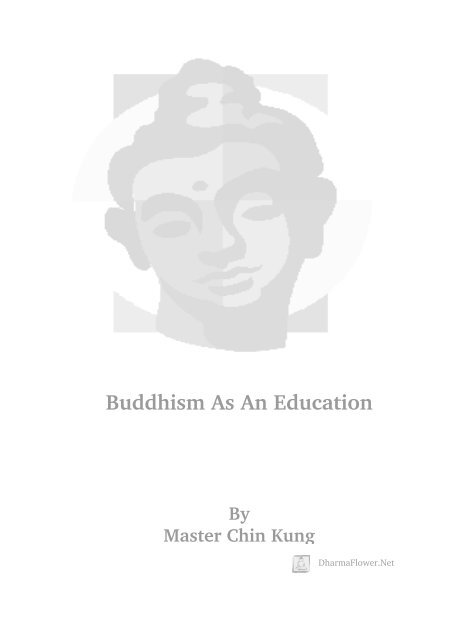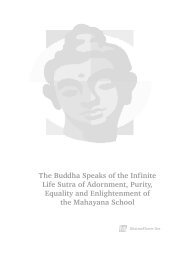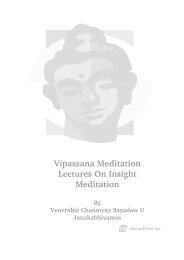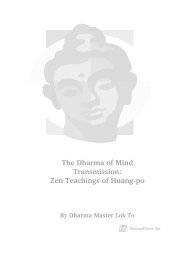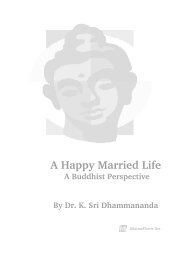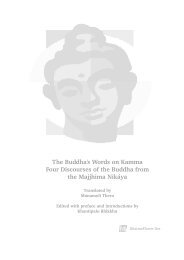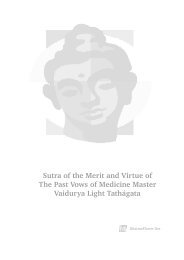Buddhism As An Education - DharmaFlower.Net
Buddhism As An Education - DharmaFlower.Net
Buddhism As An Education - DharmaFlower.Net
Create successful ePaper yourself
Turn your PDF publications into a flip-book with our unique Google optimized e-Paper software.
<strong>Buddhism</strong> <strong>As</strong> <strong>An</strong> <strong>Education</strong>ByMaster Chin Kung<strong>DharmaFlower</strong>.<strong>Net</strong>
<strong>Buddhism</strong> <strong>As</strong> <strong>An</strong> <strong>Education</strong>By Master Chin KungChapter OneThe Cause Of Our Chaotic WorldToday's societies in Taiwan and elsewhere in the world are ratherabnormal, a phenomenon that has not been witnessed before either inthe West or the East. Some Westerners have predicted that the end ofthe world will occur in 1999 and that Christ will return to earth forJudgment Day. Easterners have also predicted impending disastersthat are similar to those predictions in the West, the only differencebeing the time frame, which is some twenty years later. Some of theseare ancient prophecies, which we should not place too muchimportance on. However, if we view our environment objectively, wewill realize that this world is really in danger.Environmental pollution has become a serious problem and nowhumankind has finally begun to understand the need for protectingour environment. However, the problem of mental or spiritualpollution is many times more serious than that of the environment.This is the source of worldly ills that not many people realize. TheChinese have a saying, "<strong>Education</strong> is most essential to establish anation, train its leaders and its people." For centuries, the Chinesehave always believed in the primacy of education, which is consideredthe foundation for a peaceful and prosperous society. It provides thesolution to a myriad of social ills and leads the way to changing one'ssuffering into happiness. <strong>Education</strong> has a strong impact on the nationand its people. Moreover, elementary school is the foundation, thebasic building block in an educational system.1
Chapter Two<strong>Buddhism</strong> <strong>As</strong> <strong>An</strong> <strong>Education</strong><strong>Buddhism</strong> officially came to China in 67 AD. The Emperor had sentspecial envoys to India to invite Buddhist monks to come to China toteach <strong>Buddhism</strong>, which in that period, was regarded as aneducational system, and not as a religion. Regretfully, about twohundred years ago, the practice of <strong>Buddhism</strong> had taken on a morereligious facade. Therefore, the purpose of this talk is to correct thismisunderstanding, by leading us back to the original form of<strong>Buddhism</strong> as taught by Buddha Shakyamuni.The Goal of the Buddha's Teaching<strong>Buddhism</strong> is Buddha Shakyamuni's educational system, which issimilar to that of Confucius for both presented similar viewpoints andmethods. The goal of Buddhist education is to attain wisdom. InSanskrit, the language of ancient India, the Buddhist wisdom wascalled "<strong>An</strong>uttara-Samyak-Sambhodi" meaning the perfect ultimatewisdom. The Buddha taught us that the main objective of our practiceor cultivation was to achieve this ultimate wisdom. He further taughtus that everyone has the potential to realize this state of ultimatewisdom, as it is an intrinsic part of our nature, not something oneobtains externally. However, most of us have become confusedthrough general misconceptions and therefore, are not able to realizethis potential. Therefore, if we break through this confusion, we willrealize this intrinsic part of our nature. Thus, <strong>Buddhism</strong> is aneducational system aimed at regaining our own intrinsic nature. Italso teaches absolute equality which stemmed from Buddha'srecognition that all sentient beings possess this innate wisdom andnature. Therefore, there is no inherent difference among beings.Everyone is different now because we have lost our true nature andhave become confused. The degree of wisdom exhibited by individualsdepends on the degree of delusion and has nothing to do with the truenature of the individual. The Buddha's teaching helps us to realizethat innate, perfect, ultimate wisdom. With wisdom, we can then solveall our problems and turn suffering into happiness. Due to our lack ofwisdom, we perceive, view and behave foolishly, and thus suffer theconsequences evoked by our incorrect actions. If we have wisdom, ourthoughts, viewpoints and behavior will be correct; how then can wesuffer when there are no ill consequences to suffer from? Of course,we will be happy. From here, we can see that suffering is caused bydelusion and the source of happiness is our own realization ofwisdom.The Core of the Buddha's Teaching2
The Buddha's teaching contains three major points: discipline,meditation and wisdom. Wisdom is the goal and deep meditation orconcentration is the crucial process toward achieving wisdom.Discipline through observing the precepts, is the method that helpsone to achieve deep meditation; wisdom will then be realizednaturally. Buddha's entire teachings as conveyed in the sutras neverreally depart from these three points. <strong>Buddhism</strong> encompasses theentire collection of works by Buddha Shakyamuni and is called theTripitaka. This can be classified into three categories: sutra, vinaya(precepts or rules), and sastra (commentaries), which emphasizemeditation, discipline, and wisdom respectively.The Buddhist <strong>Education</strong>al Organization in ChinaBuddhist education is based on filial piety, as is the Chinese culture.Prior to the introduction of <strong>Buddhism</strong> to China, filial piety was thepillar of society and was supported by the wise men of ancient China.When Buddhist monks from India came to China and started todiscuss <strong>Buddhism</strong> with government officials, it was immediatelyapparent to everyone that <strong>Buddhism</strong> shared numerous similaritieswith the indigenous Confucian traditions. Consequently, thegovernment embraced them and requested that the monks stay inChina permanently.The first two monks, who came to China, Moton and Chufarlan, werereceived by the "Hong-Lu-Si" which is equivalent to our presentForeign Ministry or State Department. "Si" was designated as aministry of the government. The Chief of Hong-Lu-Si is equivalent to aforeign minister or Secretary of State. However, Hong-Lu-Si could onlyreceive foreign guests temporarily. In order to allow them to staypermanently, the Emperor added another ministry, "Bai-Ma-Si," totake charge of Buddhist education. Originally, the "Si" had nothing todo with a temple, but merely denoted a ministry of the imperial court,now it denotes a temple in contemporary Chinese. So, there were twoministries in charge of education. The "Li-Bu," managed by the PrimeMinister, was in charge of the traditional Confucian educationalsystem. This organization served the same function until the early1900's. <strong>As</strong> the Emperor had given enormous support to the "Bai-Ma-Si," Buddhist education rapidly spread throughout China. In manyinstances, it had even far exceeded the efforts to educate people thanthe traditional education system of "Li-Bu." Consequently, there maynot have been a Confucian or Manfucian school in every village, butthere was a "Si" everywhere. Again, the Buddhist "Si", or temple, usedto be an educational institution and did not perform religiousceremonies at all, unlike what often takes place in contemporarytemples nowadays.3
<strong>An</strong>other important mission for the original "Si" was sutra translation.The scale of the translation effort is hard to imagine today. During theseventh century, the famous monk Xuan-Tsuang had supervised sixhundred scholars in sutra translation. Prior to this, a monk namedKumaraja had a translation team of about four hundred scholars.Therefore, the "Si" was a large governmental organization.Unfortunately, it was completely transformed into a place to deal withsuperstition and spirits around two hundred years ago. Itseducational characteristics totally disappeared, which was trulyregretful.The Four Current Types of <strong>Buddhism</strong>Today, there are four types of <strong>Buddhism</strong> being practiced. First, thereis the religious <strong>Buddhism</strong>, which can be witnessed in templesthroughout Taiwan. However, this does not represent the real<strong>Buddhism</strong>. Second, there is the academic <strong>Buddhism</strong> being taught inmany universities today, where we see <strong>Buddhism</strong> being treated purelyas philosophy, an academic pursuit, especially in Japan. This is notexactly Buddha's education either. Third, and the most unfortunate ofall, is the total degeneration of <strong>Buddhism</strong> into a cult. This third typeof <strong>Buddhism</strong> is much more damaging to the public than the first twotypes. Finally, there is the traditional <strong>Buddhism</strong>, the teachings ofBuddha Shakyamuni in its true essence, which is very rare in our dayand age.4
Chapter ThreeThe Author's Own Experience With <strong>Buddhism</strong>When I was a young student in Nanjing, I did not believe in anyreligion. I went to church with some classmates to learn aboutChristianity. Although I tried to understand it, I could not find a wayto accept it. My favorite religion at that time was Islam because itsemphasis was on moral principles and ethics, and I thought that thiswas rare among religions. When I encountered <strong>Buddhism</strong> back then,the monks were not very convincing. Therefore, I could not accept<strong>Buddhism</strong> either and it was the one I resisted the most. I was tooyoung at that time and had not met a true practitioner.After I arrived in Taiwan, I heard of Professor Dong-Mei Fang, who wasthen a famous philosopher and a professor at the National TaiwanUniversity. Having become an admirer of his, I wrote him a letterasking about taking a class from him at the university. Professor Fangwas only in his forties at that time. He invited me to his house andtold me, "Nowadays in school, professors do not act like professors,and students do not act like students either. If you come to theuniversity and expect to learn something, you will be sorelydisappointed." When I heard this, I was pretty upset since he hadbasically poured cold water over my plans. Finally, he told me: "Well,why don't you come to my house every Sunday, and I will give youpersonal instruction for two hours." I could not believe that he was socompassionate towards me. I learned about philosophies at ProfessorFang's small table in his little living room, one on one. This wasextremely precious to me. He introduced the philosophies of the West,China, India and finally <strong>Buddhism</strong>. He taught me that <strong>Buddhism</strong> isthe pinnacle of the world's philosophy and that it provides the greatestenjoyment for humanity. What he told me was fascinating and soon Irealized that <strong>Buddhism</strong> contained something magnificent. I started tovisit the temples in Taipei. However, the monks I met in those templesjust could not clearly explain <strong>Buddhism</strong> to an intellectual skeptic likeme. However, the monks are much better in teaching <strong>Buddhism</strong>today. Then I set my first sight on Shan-Dao-Si, which was a largetemple in Taipei with a vast collection of sutras. During that period oftime, the wide publication and circulation of Buddhist books was veryrare. The monks at Shan-Dao-Si were extremely kind to me as theyallowed me to borrow many of the precious and rare sutras. This wasa great help to me.Soon after I started to learn <strong>Buddhism</strong> seriously, I was fortunate tomeet Master Zhang-Jia. He was a well-accomplished Esotericpractitioner who taught and guided me in my study and practice. Justlike Mr. Fang, he taught me two hours every week for three years untilhe passed away. I then went to Taizhong to follow Mr. Bing-Nan Leeand started studying and practicing with him.5
<strong>Buddhism</strong> is a special kind of knowledge; it is not a religion. In orderto derive true benefit from it, we have to understand its true nature. Ihave the utmost respect for <strong>Buddhism</strong> and I believe BuddhaShakyamuni to be the foremost educator in the history of the world.He was just like Confucius in that he taught everyone tirelessly andwithout discrimination.6
Chapter FourThe Methodology and Symbolism of the Buddhist <strong>Education</strong>alSystemThe Continuing <strong>Education</strong> System for TeachersThe continuing education system for teachers was first established byBuddha Shakyamuni. Many of his students were well accomplishedunder his instruction. Every year, these students were assigned toteach at different places for nine months. In India, the rainy seasonruns from mid-April to mid-July. Since it was inconvenient to traveland teach during those three months, all the students would comeback to meet with the Buddha to receive additional teachings and tolearn from each other in class discussions. This was called thesummer retreat and it parallels what is currently known as continuingeducation for teachers. The modern continuing educational system isnecessitated by the advancement in technology. However, twenty-fivehundred years ago, Buddha had already adopted this idea in bringinghis students back for additional teachings.The Artful Buddhist TeachingBuddhist teaching is full of artistic expressions. It was originally aneducation, which combined what was equivalent to to-day's museumand school system. Therefore, the "Si" combined the traditionalschool, library and museum. In ancient China, the traditional schoolsystem was not universal. Most students went to a "Si" to studybecause it usually had a complete collection of books, similar totoday's library. The collections included not only sutras, but alsoalmost every kind of publication. The monks were familiar with<strong>Buddhism</strong>, Confucianism, Taoism and ancient Chinese texts. Theywere capable of answering questions and were well versed on varioussubjects. Consequently, Buddhist institutions began to take over theeducational mission for China.Typical Buddhist buildings are expressions of art, which are called"Expressions of <strong>Buddhism</strong>." However, Buddha and Bodhisattvastatues do not represent polytheism, the worship of more than onegod. Each statue serves to inspire wisdom and awakening in each ofus. They also represent certain aspects of <strong>Buddhism</strong>, which remindpractitioners of the particular topic of teaching. For example, GuanYin Bodhisattva, the most popular Bodhisattva in China, representsInfinite Compassion. When we see this statue, it reminds us to applycompassion when dealing with the world, its people andsurroundings. However, people nowadays worship Guan YinBodhisattva as a god and pray for the relief of suffering and toeliminate obstacles. This is a superstitious view and misconceptionbecause people forget the fact that the statues are expressions ofconcepts in <strong>Buddhism</strong>.7
Buddhist architecture is also an artistic expression, with the temple'smain cultivation hall being similar to a large meeting or teaching hall.From the exterior, it appears to have two stories, but there is only onestory inside. The external two stories represent "absolute truth" or thetrue reality of life and the universe, and "relative truth" or worldlyviews still clouded with delusion. The interior single story illustratesthat both are the same truth. To the deluded, the two appear distinctand different; however, to the enlightened, they are one and the same.In the center of the main cultivation hall, there are three statues, oneBuddha and two Bodhisattvas. Buddha represents the true nature ofthe universe and human life, which is called "Buddha nature" or truemind. "Buddha" is translated from Sanskrit, and means someone whois totally enlightened. The Buddha statue represents our originalenlightenment and the Bodhisattvas statues represent the applicationof our original enlightened mind. All the representations andapplications are infinite and can be classified into two categories:wisdom and practice. For example, the Pure Land School pays respectto the Buddha and two Bodhisattvas of the Western Paradise.Amitabha Buddha (Infinite Life and Infinite Light) represents theinfinite enlightenment that is an intrinsic part of our nature.Bodhisattvas Guan Yin and Da Shi Zhi (Great Strength orMahasthamaprapta) respectively portray compassion with kindnessand great wisdom. We should be compassionate and kind toward allbeings. Our thoughts, views and behavior should be rational ratherthan emotional, for emotional behavior spells trouble. Therefore, weshould not treat the Buddha and Bodhisattvas as gods. But will theyhelp us? Yes, they will by providing us with the knowledge of how toprotect ourselves from delusion, thereby obtaining release fromsuffering. Once we have learned the background of the artisticcomponents in Buddhist architecture, music and statues, we will gainan enriched experience when paying a visit to a traditional Buddhisttemple.However, nowadays many people do not understand the meaning andteachings of <strong>Buddhism</strong>. They mistake the multi-representations ofBodhisattvas as a sign of polytheism. What people fail to understandis the fact that the statues in <strong>Buddhism</strong> are teaching aids and notstatues of gods. All Buddhas and Bodhisattvas represent our natureand cultivation of virtue. We have infinite capabilities within our truenature that cannot be expressed by just one single term. Therefore, wehave multiple representations; for instance, a capable person todaymay have many titles on his/her business cards to show his/herpositions and accomplishments. The Buddha and Bodhisattvas areactually representations of the nature within ourselves: Buddha, as inour true nature of mind, and the Bodhisattvas, in our virtue ofcultivation. We all possess these qualities. Not until we come to realizethe meaning of Buddhist symbolism, will we appreciate thesophistication and completeness of its education.8
Typical "Si" buildings are rare today. The first hall of a "Si" is the hallof Heavenly Guardians, also known as Dharma Protectors. Situated inthe center of the hall, facing the front door, is Mi Le Pu Sa (MaitreyaBodhisattva) who is represented by the image of the historical monkBu-Dai. Mi Le Pu Sa has a big smile that conveys the idea that inorder to truly learn <strong>Buddhism</strong>, one should learn to be cheerful andcourteous to all. He also has a huge belly that represents fairness,flexibility, impartiality, patience and tolerance.Standing beside Mi Le Pu Sa are the four Heavenly Guardians orDharma Protectors. They are symbolic guardians of the practitionersof the Buddhist way. Whom do they protect? They protect us byreminding us to educate ourselves and to safeguard the properknowledge, which we should learn. Each guardian portrays a differentaspect of thought or action.The Eastern Dharma Protector (holding a lute) symbolizesresponsibility and safeguards the territory, which means that all of usare responsible for ourselves, our family, society and the country as awhole. If each of us performs our duties well, fulfilling our obligations,we support each other and ourselves as well. The Southern DharmaProtector (holding a sword) symbolizes progress and teaches usdiligence. He emphasizes the importance of constantly cultivating andadvancing our virtue, wisdom and knowledge, and to improveperformance in ourselves and our duties. This is similar to Confucianideas of daily self-improvement.The Western Dharma Protector (holding a dragon or snake) symbolizescomprehensive vision and knowledge gained through exposure to theworld. He represents the need to open our eyes to observe nature andman, to refine what we see and learn, and to distinguish good from ill.The Northern Dharma Protector (holding an umbrella) symbolizescomprehensive study and learning. Both teach ways of practice andhow to achieve the goals in responsibility fulfillment and selfimprovement.<strong>As</strong> the ancient Chinese have said: "To read tenthousand books and to travel ten-thousand miles." We read to gainmore knowledge and travel to observe more effectively. We will then beable to improve ourselves and to perform our duties most effectively.Today, people visit the Hall of Dharma Protectors to burn incense,prostrate and offer flowers and fruit praying for protection and safety.This is superstition. All the facilities, images of Buddha andBodhisattvas and any offerings made are teaching tools designed toinspire our mind and wisdom. They also serve to remind us of theimportance of being enlightened instead of deluded, virtuous insteadof deviated, pure instead of polluted. These are the three principles ofBuddhist teaching and practice.9
Methods of Practicing <strong>Buddhism</strong>The ways in practicing <strong>Buddhism</strong> are numerous, about eighty-fourthousand. Each path is different from the others but ultimately leadsto the same goals: enlightenment, proper thoughts and viewpoints,and purity. <strong>As</strong> such, all paths are equal without one being superior tothe other. People have different abilities and levels of accomplishment.Furthermore, they are from different environments and should choosea path most suited to them. We can choose any one of the three goalsto concentrate our practice on. When we achieve any one of them, theother two will come naturally.There are ten schools of practice in Chinese <strong>Buddhism</strong>. Zen stressesthe pursuit of the perfect clear mind or enlightenment. The Pure Landand Tibetan <strong>Buddhism</strong> or Vajrayâna School stress obtaining the puremind. Other schools concentrate their practice on proper thoughtsand viewpoints. Regardless of which method or school one chooses,they all lead to the same outcome. In other words, once we becomeexpert in one method, we will become an expert in all methods.Today's societies in Taiwan and elsewhere in the world are ratherabnormal, a phenomenon that has not been witnessed before either inthe West or the East. Some Westerners have predicted that the end ofthe world will occur in 1999 and that Christ will return to earth forJudgment Day. Easterners have also predicted impending disastersthat are similar to those predictions in the West, the only differencebeing the time frame, which is some twenty years later. Some of theseare ancient prophecies, which we should not place too muchimportance on. However, if we view our environment objectively, wewill realize that this world is really in danger.Environmental pollution has become a serious problem and nowhumankind has finally begun to understand the need for protectingour environment. However, the problem of mental or spiritualpollution is many times more serious than that of the environment.This is the source of worldly ills that not many people realize. TheChinese have a saying, "<strong>Education</strong> is most essential to establish anation, train its leaders and its people." For centuries, the Chinesehave always believed in the primacy of education, which is consideredthe foundation for a peaceful and prosperous society. It provides thesolution to a myriad of social ills and leads the way to changing one'ssuffering into happiness. <strong>Education</strong> has a strong impact on the nationand its people. Moreover, elementary school is the foundation, thebasic building block in an educational system.10
Chapter FiveThe Integration Of Confucianism <strong>An</strong>d <strong>Buddhism</strong><strong>Buddhism</strong> successfully merged into Chinese culture; they becameinseparable. The basic concept that they share is to give up one's owninterest for the sake of others. Confucianism and <strong>Buddhism</strong> advocatethe enhancement and glorification of filial piety, the respect anddevotion of an individual for their parents and teachers. Filial piety isa major element in accomplishing world peace.What is education? It is the meaning and the value of human life, therelationships between human beings as well as those betweenhumans and the universe. Confucian teaching encompasses threemain points. First, it is important to understand the relationshipbetween humans, once this is understood we will learn to love people.Second, it is important to understand the relationship betweenhumans and heaven, once this is understood we will learn to respectheavenly beings and spirits. Third, it is important to understand therelationship between humans and the environment, once this isunderstood we will learn to take care of the environment and toappreciate every single thing around us. There are four studies withinConfucian teachings: virtue, speech, skills for earning a living and thearts. The teaching of virtue is the core of Confucianism; it isabsolutely crucial, for without morality and proper conduct webecome selfish and concerned only with ourselves at the expense ofsociety. Such behavior can result in world chaos. Today, oureducation has lost that emphasis. Schools only teach skills that aresuperficial and not the root of education. When the root is rotten, itshakes the foundation of society and causes the chaos that we areexperiencing today. Elementary schools are like the root of education:junior highs, high schools, and colleges are the flowers and leaves.Teachers can start teaching filial piety to our children as early aspossible.By looking at the way Chinese characters were created, we cannot butadmire our ancestor's high level of wisdom. We thank them for havinggiven us something that is so valuable and exquisite. The Chinesecharacter "piety" embraces the spirit of <strong>Buddhism</strong> and the foundationof education as it is a combination of the characters for "old" and"son." Nowadays, people talk about the generation gap betweenparents and children, which is something traditional families did nothave. In the Chinese tradition, not only are father and son one unit;grandfathers and grandsons, etc. are all part of the same continuum.This is a unique concept. Westerners often ask why Chinese peoplepay respect to ancestors since we barely know them. Theremembrance of our ancestors is the foundation of Confucianism and<strong>Buddhism</strong>, which is the source of harmony in society and peace in theworld.11
Today everyone longs for world peace, but we need to start from thefoundation of filial piety to obtain it. <strong>Buddhism</strong> emphasizesunconditional compassion for all sentient beings in the universe andbeyond; in the past, present and future. The continuum of time andspace is inseparable from oneself, for We Are All One Entity. One doesnot find this extensive concept in religion. "Thus Come One", one ofthe ten names for Buddha, stands for an enlightened being, which isour basic nature, and also the essence of the universe and human life.This concept is embodied by the Chinese character "piety" and thename of Amitabha Buddha in the Pure Land School. The names maybe different but the meanings are the same: unconditional love for allbeings that surpasses space and time.The Five Human RelationshipsConfucian teachings are based on five human relationships that arefounded on moral principles. The five human relationships includethose between husband/wife, parent/child, siblings, friends, andpolitical leaders and the public. Husband/wife represents the smallestand the most intimate circle of human relationships. Outside thesmall circle is the extended family, which includes the relationshipsbetween father and son and those among the siblings. Outside thefamily there is society, which includes additional relationshipsbetween the individual and his leader and circles of friends. We nowoften talk about the need to unite people. In ancient times, theChinese had no use for the word "unite," for the five humanrelationships define the union of all people. Everyone on this earth isour brother. Each is responsible for the other; parents beingcompassionate, sons and daughters being filial to their parents,siblings and friends being respectful to each other. In this way, thecountry and its people are already a perfect union. The relationshipsbetween people also define responsibilities from one to the other.Everyone has his own duty and responsibility to fulfill.The Practice of Confucianism and <strong>Buddhism</strong>Human beings differ from animals by adhering to humanrelationships and basic moral principles. The practice of Confucianismis based on having sincere and proper thoughts, correct behavior, awell-organized and harmonious family and country, and peace for all.This is identical to the views of <strong>Buddhism</strong>, which also emphasizespracticing and learning. It all starts from generating the Bodhicittamind. "Bodhi" is a Sanskrit word meaning enlightenment.Enlightenment means an "awakened" mind. It is similar to the sincerethought and proper mind advocated by Confucianism. A Chinesegovernment official defined sincerity very well. He noted that "Sincerity12
textbooks. During that period, all the textbooks were printed in theuniversal format: twenty words per column and ten columns per page,with no space in between. The format was standard for the entirecountry regardless of the publisher. Both teacher and studentsmemorized the textbooks so well that they even knew exactly wherethe study materials were located. Since everything had beenmemorized earlier, there was no need for books after elementaryschool.Teachers often took their students on field trips to broaden theirknowledge and experience. <strong>As</strong> they traveled, knowledge was impartedto them along the way. Thus, the trips were without textbooks orrestraints but accompanied with wine and food and filled with joy. Thestudents would attend to the needs of the teacher. Therefore, as theyconcluded their travels to the many beautiful places, the course wouldclose as well. For many, attending Tai school was the most joyful timeof their lives.In Taiwan, those who are in their eighties or nineties may haveexperienced this kind of education. My late teacher, Mr. Lee, then inhis nineties, could still apply materials he had memorized inelementary school when writing articles; no reference materials wereneeded. This was the method he used to acquire the original wisdomthat comes from the pure mind. With the pure mind, true wisdomarises. Having true wisdom is to know a person's past and future andalso to understand the laws of cause and effect. One should not judgethings by their appearance, but know and understand how eventscame about. The wisdom of knowing nothing emphasized in<strong>Buddhism</strong> is the original wisdom. Only when one has a pure mind,which contains nothing, will he also know everything when he is incontact with the external world. Therefore, the practicing and studyingof <strong>Buddhism</strong> begins with eliminating all thoughts in order to obtain apure mind.All this made me think of our children, who are so pure, so innocentand uncontaminated in their thinking which is why it is best for ourchildren to start learning <strong>Buddhism</strong> early in childhood. With littleeffort, children can truly and easily benefit from it. The experiences ofa person with a pure mind are so different and profound that noordinary person can truly appreciate them.World Peace Can be Achieved if the Mind and Body are Welltrained,theFamily is Well-run and the Country is Well-governed.A true practitioner will keep himself from being greedy, angry,ignorant and arrogant toward others and his environment. If one hasany of the elements just mentioned, then he is neither sincere norproper. Sincerity and proper thoughts and viewpoints are the basis fortraining the mind. A person with a pure mind and body will notbecome ill. We suffer from illnesses because our minds are filled with14
wandering thoughts and worries that are derived from greed, anger,ignorance and arrogance.<strong>As</strong> mentioned earlier, sincerity and proper thoughts and viewpointsare the basis for purifying one's mind. A purified mind leads to apurified body and naturally, a person will become immune fromillness; thus, a realized practitioner would never get seriously ill.Moreover, if a person is determined to follow the path of Buddha, heor she will not die in the conventional manner. A conventional deathmeans a person does not know exactly when they will leave this world,nor where they will go afterwards. On the other hand, truepractitioners with confidence in themselves and in Amitabha Buddha,who cultivate in accordance with Buddhist teachings, will be capableof controlling both the time of leaving this world and of being born inthe Western Pure Land. This is neither unusual nor a fairy tale, butthe simple truth, and can be achieved by cultivating the pure mindand vowing to reach the Western Pure Land. Therefore, one needs tounderstand how important it is to be free of worries and attachments.Every Buddhist should maintain a pure mind and body at all times,treating everyone and everything with equality and composure. Onlythen would the family be in harmony, the society in unity and theworld at peace. No longer would we have feuds, conflicts or wars. Thepeace and happiness, which we all wish for today, would no longer bea dream. World peace can be achieved if we combine Confucianismand <strong>Buddhism</strong> into our educational system.The Eight Basic Confucian Moral PrinciplesLoyalty, filial piety, compassion, love, trust-worthiness, responsibility,peace and equality are the eight basic Confucian moral principles andare represented by four Bodhisattvas in <strong>Buddhism</strong>. Di Tsang Wang(Earth Store /Kristigharba) Bodhisattva represents filial piety andtherefore the Di Tsang Sutra is known as the Filial Piety Sutra. This isbecause it teaches filial respect for both parents and teachers, who areboth equally important in <strong>Buddhism</strong> and Confucianism. To treat one'sparents with filial piety and to respect teachers are the innate virtuesof human nature. The goal of Buddhist teaching is for us to realize thetrue nature of the mind, which can only be achieved by discovering itsvirtuous nature, without which one will never become enlightened.Guan Yin Bodhisattva symbolizes compassion and representskindness and love. Wen Shu Shi Li (Manjusri) Bodhisattva symbolizeswisdom and represents faith and loyalty. Pu Xian (UniversalWorthy/Samantabhadra) Bodhisattva symbolizes great vows andputting the Buddha's teaching into practice including filial piety,compassion and wisdom. He represents peace and equality. Withcompassion and wisdom, one can generate merits. To enjoy merits is15
without virtue of merits and good causes and conditions, practitionerscannot find good teachers. Therefore, I always encourage youngpractitioners to resolve to save our country and the world.18
The Dharma Protector BodhisattvaTransference of MeritMay the Merits and Virtues accrued fromthis work,Adorn the Buddhas’ Pure Lands,Repaying the Four Kinds of Kindnessabove,<strong>An</strong>d aiding those suffering in the pathsbelow.May those who see and hear of this,All bring forth the resolve of Bodhi,<strong>An</strong>d when this retribution body is over,Be born together in Ultimate Bliss.


